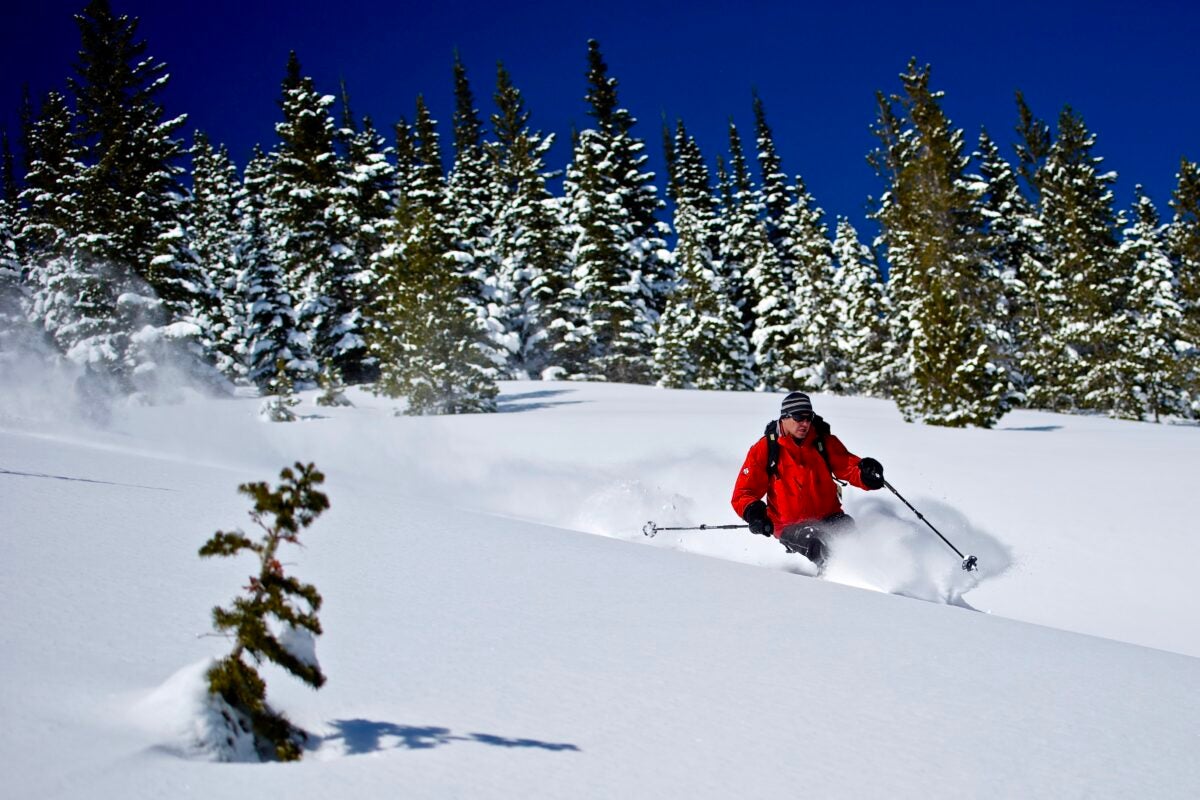Products You May Like
Heading out the door? Read this article on the new Outside+ app available now on iOS devices for members!
Download the app.
The National Ski Patrol’s mission to help keep people safe on the mountain and during other outdoor activities is simple by definition yet extremely complex in execution. After all, it takes a group of highly skilled, highly dedicated, and highly trained individuals to ensure the safest mountain conditions for skiers and riders.
These formidable responsibilities often fall directly on the shoulders of seniors, those patrollers age 60 and above, who comprise a sizeable portion of many ski patrols throughout the country. At Shawnee Mountain Ski Area in Pennsylvania’s Pocono Mountains, 28 patrollers are 60 or older, with 36 being the average number of years served.
Jan Wyckoff, 62, is on patrol at Shawnee in her fourteenth year. I saw great, cohesive team members who were smart, hard-working, and fun-loving. I wanted to be a part of that.
According to Wyckoff, every day is different. “When we’re free skiing we always need to be on the lookout for a lot of things, but primarily guests who may need assistance,” she says. Other responsibilities include snow fencing, markers, rope, and other elements needing replacing. She adds, “I usually spend my afternoons in our Base Patrol First Aid. When a guest is injured on the mountain, patrollers will bring them down to first aid in toboggans for treatment. Patrollers in Base Patrol are also responsible for responding to calls at the beginner area and at our base lodges.” Skiing the east, as Wyckoff does, means patrolling in all types of weather conditions. She says, “We have an incredible number of guests who will ski and ride in any kind of weather. And that means we have to be out there as well, even if we’d rather be inside Base Patrol sipping on hot chocolate.”
While in high school, Bill Somers, now 71, spent two years as a member of the Junior Patrol. After he went off to college, he dropped out of patrolling but always felt drawn to it, he says. he explains.
When Somers moved from Denver to Los Alamos, New Mexico, for work, skiing at nearby Pajarito Mountain Ski Area, the idea of joining a ski patrol reignited. When his wife got hurt on their first day of skiing, Somer’s experience with patrol led him to volunteer. That was 32 years ago now.
“The idea of using my skiing skills to help people on the slopes and give back to the sport I love drove my interest. Also, the opportunity to learn rescue techniques, provide medical assistance, get avalanche training, and just the camaraderie of people with similar interests drew me to it.”
A typical day for Somers starts in the patrol room, booted up and ready to ski by 8 a.m. Patrollers are assigned opening duties, a closing route, and times for sitting as First Responder, Dispatch, and Patrol Room. During their morning meeting, patrollers get additional assignments such as marking new hazards and closing trails. He says, “We are on the lifts before the area opens to do our morning checks and other duties. Then it is skiing, helping people with questions, occasionally educating guests on skiing etiquette and the responsibility code. If there is an accident reported maybe jumping in to help in some way or being the first responder. Also, I may do some toboggan training with new candidates or a refresher for current patrollers. At closing, I’ll do one of the routes to ensure guests are off the mountain.”
Every so often, patrollers face extreme challenges. A chairlift breaks down, and a lift evacuation is necessary, made even more complex in deep snow. On other days it may be a helicopter evacuation of a patient, multiple major incidents, a complicated rescue right at closing time, or searching for a lost skier late at night in a snowstorm.
Despite often herculean efforts, senior patrollers know their limits. Some will give up running toboggans or lift evacuation duties, the most physically demanding parts of the job. However, they stay active as Outdoor Emergency Care instructors training new patrollers, helping with refreshers, staffing the aid room, operating a snowmobile, and doing things that can free up younger patrollers for other work.
Seniors such as Steve Morrison, 64, now in his fortieth year on patrol at multiple Canadian ski areas, including Fernie Alpine Resort, Whistler Mountain, and Cypress Bowl, bring to the mountain knowledge and experience that has become invaluable to young patrollers on staff.
“Steve’s mentorship has been invaluable to my career as a ski patroller,” says Matt Lewis at Fernie Alpine Resort Ski Patrol. “His knowledge of the terrain on the mountain, down to the most minute detail, is unmatched. Route training with Steve is always educational and often hilarious. He has endless tricks up his sleeve to deal with any situation on the mountain and the experience of walking us through difficult rescues, first aid calls and avalanche control missions. I feel very fortunate and grateful to work with and learn from one of the best.”
Senior Vice President of Resorts of the Canadian Rockies, Matt Mosteller, adds, “Seniors’ knowledge in every aspect of running a ski operation is indispensable, and it is core to a snow safety program as Mother Nature throws so many variables at you. If you don’t have this senior crew, you may not recognize or find solutions to deal with situations.”
